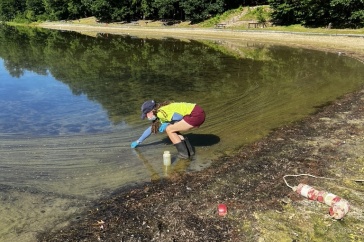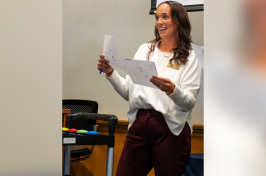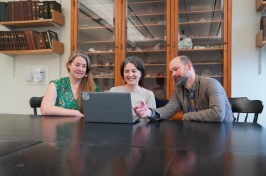Taking Flight, More Effectively Monitoring Harmful Algae Blooms in New Hampshire Lakes

Researcher Christine Bunyon collects a cyanobacteria sample from Keyser Pond in Henniker, New Hampshire. Photo courtesy: Christine Bunyon / UNH
DURHAM, N.H.—The lakes of New Hampshire are popular destinations for both residents and visitors to the Granite State, offering multiple recreational options like swimming, boating and fishing. As climate change affects temperatures on both land and in water, this can also increase toxic blue-green algae blooms, known as cyanobacteria, that can carry potential health risks for adults, children and pets. Testing each suspicious body of water can be expensive and time-consuming but researchers at the University of New Hampshire have developed a promising alternative by using unmanned aerial systems (UAS), or drones, equipped with special sensors to help identify the harmful blooms faster and more efficiently.
“This was the first study of its kind done on lakes in New Hampshire, which is surprising because cyanobacteria blooms are becoming an increasing public and ecological issue all across New England,” said Russell Congalton, professor of natural resources and the environment and a scientist at the N.H. Agricultural Experiment Station. “With so many bodies of water across the region, testing water samples can get expensive but drones offer a faster, simpler and safer alternative, with very little exposure to the toxin for those performing the tests.”
In their study, published in the journal of Remote Sensing, the researchers outlined how they used UAS equipped with a multispectral sensor to capture imagery in various wavelengths of the electromagnetic spectrum (blue, green red, red edge and near infrared) which allowed for the accurate detection, identification and quantification of certain parts of the aquatic ecosystem, like the blue-green and green algae.
They flew the drone over six bodies of water in southern New Hampshire: Silver Lake and French, Greenwood, Keyser, Showell and Tucker ponds. The drone collected images of the lake in a lateral grid pattern that enabled researchers to accurately analyze and determine cyanobacteria concentrations. Water samples were also collected by a researcher who would canoe to selected locations in the lake. These samples were then analyzed in a water quality lab and used to determine the accuracy of the results of the image analysis.
The team conducted their water surveys from May 2022 to September 2022 and collected samples from each of the six bodies of water. They analyzed and processed over 180 water samples for chlorophyll-a—each sample taking over two days to analyze. Comparatively, the collection and processing of the UAS imagery took significantly less time—about 4.5 times faster—than the traditional water sampling method.
“With the UAS, a small lake might take as little as 10 to 15 minutes to fly over and less than an hour to do everything including set up, flying and packing away the equipment—and an entire lake’s worth of imagery could be processed within just two hours,” said Christine Bunyon, a UNH graduate student researcher and its lead author. "The traditional method of testing for cyanobacteria took so much longer because each sample had to be collected and processed individually. Ultimately, the ability to use this technology streamlined the entire process and eliminated significant time spent in the lab.”
The study also revealed a correlation between cyanobacteria cell concentration and concentrations of chlorophyll-a and phycocyanin—the latter being a pigment responsible for the blue-green algae's color. This correlation allowed for the use of spectral imagery to identify cyanobacteria, chlorophyll-a and phycocyanin concentrations in the water, aiding in determining potential harm levels.
Other co-authors include Amanda McQuaid, UNH Extension specialist and Benjamin Fraser, a postdoctoral researcher.
The research was funded by the USDA National Institute of Food and Agriculture, the N.H. Agricultural Experiment Station and the state of New Hampshire.
Founded in 1887, the NH Agricultural Experiment Station at the UNH College of Life Sciences and Agriculture is UNH’s first research center and an elemental component of New Hampshire's land-grant university heritage and mission.
The University of New Hampshire inspires innovation and transforms lives in our state, nation and world. More than 16,000 students from 49 states and 82 countries engage with an award-winning faculty in top-ranked programs in business, engineering, law, health and human services, liberal arts and the sciences across more than 200 programs of study. A Carnegie Classification R1 institution, UNH partners with NASA, NOAA, NSF, and NIH, and received over $210 million in competitive external funding in FY23 to further explore and define the frontiers of land, sea and space.
PHOTOS AND IMAGES FOR DOWNLOAD
https://colsa.unh.edu/file/45687
Researcher Christine Bunyon collects a cyanobacteria sample from Keyser Pond in Henniker, New Hampshire.
Photo courtesy: Christine Bunyon / UNH
https://colsa.unh.edu/file/45690
A photo of the unpiloted aerial system (UAS), a model DJI Matrice 300 RTK, used for capturing image data on cyanobacteria blooms in New Hampshire.
Photo courtesy: Christine Bunyon / UNH
https://colsa.unh.edu/file/45688
A map of Keyser Pond, showing locations of sampling (blue points) and transect lines (yellow) that the UAS followed for capturing overhead aerials.
Courtesy: Christine Bunyon / UNH
https://colsa.unh.edu/file/45689
A pie chart providing an approximate comparison of the amount of time each task took to complete. Blue sections represent those associated with the collection and processing of water quality parameters. Grayscale sections represent those associated with the collection and processing of UAS parameters. Traditional water quality tasks took roughly 310 hours to complete while UAS tasks took roughly 65 hours to complete.
Graphic courtesy: Christine Bunyon / UNH
Latest News
-
November 22, 2024
-
November 7, 2024
-
October 30, 2024
-
October 10, 2024
-
October 8, 2024



















































